Chapter 08 Quadrilaterals
8.1 Properties of a Parallelogram
You have already studied quadrilaterals and their types in Class VIII. A quadrilateral has four sides, four angles and four vertices. A parallelogram is a quadrilateral in which both pairs of opposite sides are parallel. Let us perform an activity.
Cut out a parallelogram from a sheet of paper and cut it along a diagonal (see Fig. 8.1). You obtain two triangles. What can you say about these triangles?
Place one triangle over the other. Turn one around, if necessary. What do you observe?
Observe that the two triangles are congruent to each other.
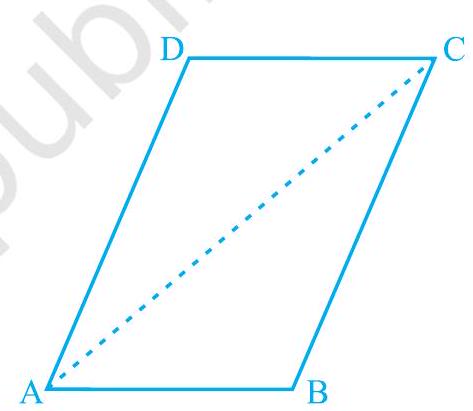
Fig. 8.1
Repeat this activity with some more parallelograms. Each time you will observe that each diagonal divides the parallelogram into two congruent triangles. Let us now prove this result.
Theorem 8.1 : A diagonal of a parallelogram divides it into two congruent triangles.
Proof : Let $A B C D$ be a parallelogram and $A C$ be a diagonal (see Fig. 8.2). Observe that the diagonal $\mathrm{AC}$ divides parallelogram $\mathrm{ABCD}$ into two triangles, namely, $\triangle \mathrm{ABC}$ and $\triangle \mathrm{CDA}$. We need to prove that these triangles are congruent.
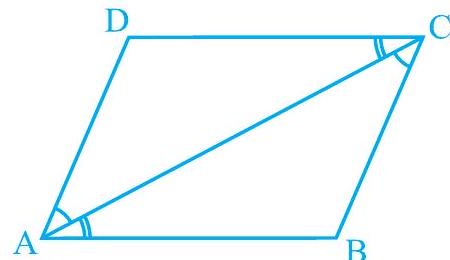
Fig. 8.2
In $\triangle \mathrm{ABC}$ and $\triangle \mathrm{CDA}$, note that $\mathrm{BC} || \mathrm{AD}$ and $\mathrm{AC}$ is a transversal.
So, $\quad \angle \mathrm{BCA}=\angle \mathrm{DAC}$ (Pair of alternate angles)
Also, $\quad\mathrm{AB} | \mathrm{DC}$ and $\mathrm{AC}$ is a transversal.
So, $\quad \angle \mathrm{BAC}=\angle \mathrm{DCA}$ (Pair of alternate angles)
and $\quad \mathrm{AC}=\mathrm{CA}\quad$(Common)
So, $\quad \Delta \mathrm{ABC} \cong \triangle \mathrm{CDA}\quad$(ASA rule)
or, diagonal $\mathrm{AC}$ divides parallelogram $\mathrm{ABCD}$ into two congruent triangles $\mathrm{ABC}$ and $\mathrm{CDA}$.
Now, measure the opposite sides of parallelogram $A B C D$. What do you observe?
You will find that $\mathrm{AB}=\mathrm{DC}$ and $\mathrm{AD}=\mathrm{BC}$.
This is another property of a parallelogram stated below:
Theorem 8.2 : In a parallelogram, opposite sides are equal.
You have already proved that a diagonal divides the parallelogram into two congruent triangles; so what can you say about the corresponding parts say, the corresponding sides? They are equal.
So, $\mathrm{AB}=\mathrm{DC}$ and $\mathrm{AD}=\mathrm{BC}$
Now what is the converse of this result? You already know that whatever is given in a theorem, the same is to be proved in the converse and whatever is proved in the theorem it is given in the converse. Thus, Theorem 8.2 can be stated as given below :
If a quadrilateral is a parallelogram, then each pair of its opposite sides is equal. So its converse is :
Theorem 8.3 : If each pair of opposite sides of a quadrilateral is equal, then it is a parallelogram.
Can you reason out why?
Let sides $\mathrm{AB}$ and $\mathrm{CD}$ of the quadrilateral $\mathrm{ABCD}$ be equal and also $\mathrm{AD}=\mathrm{BC}$ (see Fig. 8.3). Draw diagonal AC.
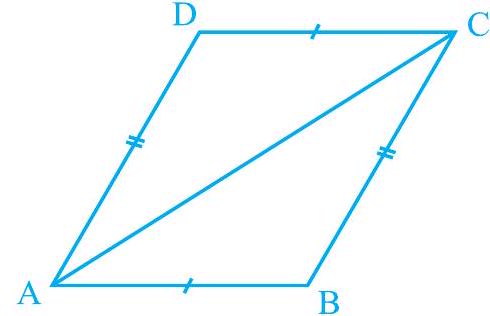
Fig. 8.3
Clearly, $\quad \triangle \mathrm{ABC} \cong \triangle \mathrm{CDA}\quad$(Why?)
So, $\quad \angle \mathrm{BAC}=\angle \mathrm{DCA}$
and $\quad \angle \mathrm{BCA}=\angle \mathrm{DAC}\quad$(Why?)
Can you now say that ABCD is a parallelogram? Why?
You have just seen that in a parallelogram each pair of opposite sides is equal and conversely if each pair of opposite sides of a quadrilateral is equal, then it is a parallelogram. Can we conclude the same result for the pairs of opposite angles?
Draw a parallelogram and measure its angles. What do you observe?
Each pair of opposite angles is equal.
Repeat this with some more parallelograms. We arrive at yet another result as given below.
Theorem 8.4 : In a parallelogram, opposite angles are equal.
Now, is the converse of this result also true? Yes. Using the angle sum property of a quadrilateral and the results of parallel lines intersected by a transversal, we can see that the converse is also true. So, we have the following theorem :
Theorem 8.5 : If in a quadrilateral, each pair of opposite angles is equal, then it is a parallelogram.
There is yet another property of a parallelogram. Let us study the same. Draw a parallelogram $\mathrm{ABCD}$ and draw both its diagonals intersecting at the point $\mathrm{O}$ (see Fig. 8.4).
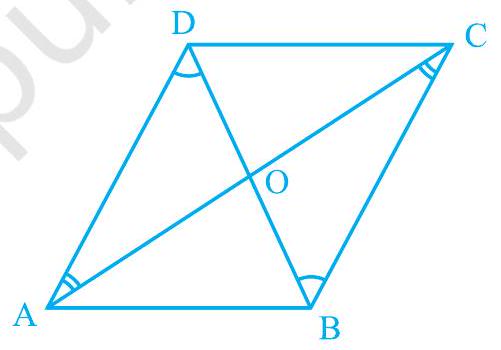
Fig. 8.4
Measure the lengths of $\mathrm{OA}, \mathrm{OB}, \mathrm{OC}$ and $\mathrm{OD}$.
What do you observe? You will observe that
$\mathrm{OA}=\mathrm{OC} \text { and } \mathrm{OB}=\mathrm{OD}$
or, $\mathrm{O}$ is the mid-point of both the diagonals.
Repeat this activity with some more parallelograms.
Each time you will find that $\mathrm{O}$ is the mid-point of both the diagonals.
So, we have the following theorem :
Theorem 8.6 : The diagonals of a parallelogram bisect each other.
Now, what would happen, if in a quadrilateral the diagonals bisect each other? Will it be aparallelogram? Indeed this is true.
This result is the converse of the result of Theorem 8.6. It is given below:
Theorem 8.7 : If the diagonals of a quadrilateral bisect each other, then it is a parallelogram.
You can reason out this result as follows:
Note that in Fig. 8.5, it is given that $\mathrm{OA}=\mathrm{OC}$ and $\mathrm{OB}=\mathrm{OD}$.
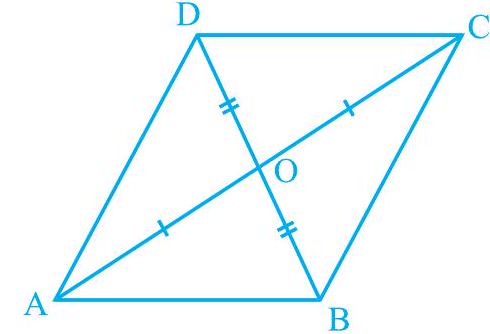
Fig. 8.5
So,$\quad \triangle \mathrm{AOB} \cong \triangle \mathrm{COD} \quad \text { (Why?) }$
Therefore, $\angle \mathrm{ABO}=\angle \mathrm{CDO}\quad \text {(Why?)}$
From this, we get $\mathrm{AB} || \mathrm{CD}$
Similarly, $\quad \mathrm{BC} || \mathrm{AD}$
Therefore $\mathrm{ABCD}$ is a parallelogram.
Let us now take some examples.
Example 1 : Show that each angle of a rectangle is a right angle.
Solution : Let us recall what a rectangle is.
A rectangle is a parallelogram in which one angle is a right angle.
Let $\mathrm{ABCD}$ be a rectangle in which $\angle \mathrm{A}=90^{\circ}$.
We have to show that $\angle \mathrm{B}=\angle \mathrm{C}=\angle \mathrm{D}=90^{\circ}$
We have, $A D || B C$ and $A B$ is a transversal (see Fig. 8.6).
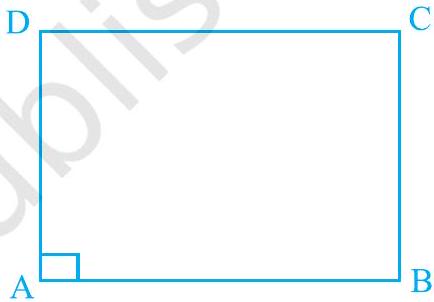
Fig. 8.6
So, $\angle \mathrm{A}+\angle \mathrm{B}=180^{\circ} \quad$ (Interior angles on the same side of the transversal)
But, $\quad \angle \mathrm{A}=90^{\circ}$
So, $\quad \angle \mathrm{B}=180^{\circ}-\angle \mathrm{A}=180^{\circ}-90^{\circ}=90^{\circ}$
Now, $\quad \angle \mathrm{C}=\angle \mathrm{A}$ and $\angle \mathrm{D}=\angle \mathrm{B}$
(Opposite angles of the parallellogram)
So,$\quad\angle \mathrm{C}=90^{\circ} \text { and } \angle \mathrm{D}=90^{\circ} \text {. }$
Therefore, each of the angles of a rectangle is a right angle.
Example 2 : Show that the diagonals of a rhombus are perpendicular to each other.
Solution : Consider the rhombus ABCD (see Fig. 8.7).
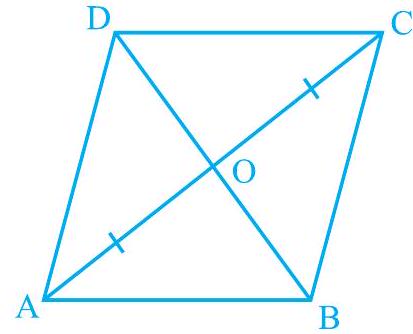
Fig. 8.7
You know that $\mathrm{AB}=\mathrm{BC}=\mathrm{CD}=\mathrm{DA}$ (Why?)
Now, in $\triangle \mathrm{AOD}$ and $\triangle \mathrm{COD}$,
$\mathrm{OA}=\mathrm{OC}($ Diagonals of a parallelogram bisect each other)
$\mathrm{OD}=\mathrm{OD}\quad$(Common)
$\mathrm{AD}=\mathrm{CD}$(Given)
Therefore, $\Delta \mathrm{AOD} \cong \Delta \mathrm{COD}\quad$(SSS congruence rule)
This gives, $\angle \mathrm{AOD}=\angle \mathrm{COD}\quad$ (CPCT)
But, $\angle \mathrm{AOD}+\angle \mathrm{COD}=180^{\circ}$ (Linear pair)
So, $\quad 2 \angle \mathrm{AOD}=180^{\circ}$
or, $\quad \angle \mathrm{AOD}=90^{\circ}$
So, the diagonals of a rhombus are perpendicular to each other.
Example 3 : $\mathrm{ABC}$ is an isosceles triangle in which $\mathrm{AB}=\mathrm{AC}$. $\mathrm{AD}$ bisects exterior angle $\mathrm{PAC}$ and $\mathrm{CD} | \mathrm{AB}$ (see Fig. 8.8). Show that
(i) $\angle \mathrm{DAC}=\angle \mathrm{BCA}$ and
(ii) $\mathrm{ABCD}$ is a parallelogram.
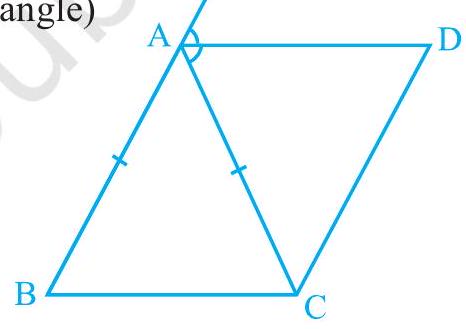
Fig. 8.8
Solution : (i) $\triangle \mathrm{ABC}$ is isosceles in which $\mathrm{AB}=\mathrm{AC}$ (Given)
So, $\quad \angle \mathrm{ABC}=\angle \mathrm{ACB} \quad$ (Angles opposite to equal sides)
Also, $\angle \mathrm{PAC}=\angle \mathrm{ABC}+\angle \mathrm{ACB}\quad$(Exterior angle of a triangle)
or, $\quad \angle \mathrm{PAC}=2 \angle \mathrm{ACB}\quad$(1)
Now, AD bisects $\angle \mathrm{PAC}$.
So, $\quad \angle \mathrm{PAC}=2 \angle \mathrm{DAC}\quad$(2)
Therefore,
$2 \angle \mathrm{DAC} =2 \angle \mathrm{ACB} \quad[\text { From }(1) \text { and }(2)]$ $\text { or, } \quad \angle \mathrm{DAC} =\angle \mathrm{ACB}$
(ii) Now, these equal angles form a pair of alternate angles when line segments $\mathrm{BC}$ and $\mathrm{AD}$ are intersected by a transversal $\mathrm{AC}$.
So, $\quad \mathrm{BC} || \mathrm{AD}$
Also, $\mathrm{BA} || \mathrm{CD} \quad$ (Given)
Now, both pairs of opposite sides of quadrilateral $\mathrm{ABCD}$ are parallel.
So, $A B C D$ is a parallelogram.
Example 4 : Two parallel lines $l$ and $m$ are intersected by a transversal $p$ (see Fig. 8.9). Show that the quadrilateral formed by the bisectors of interior angles is a rectangle.
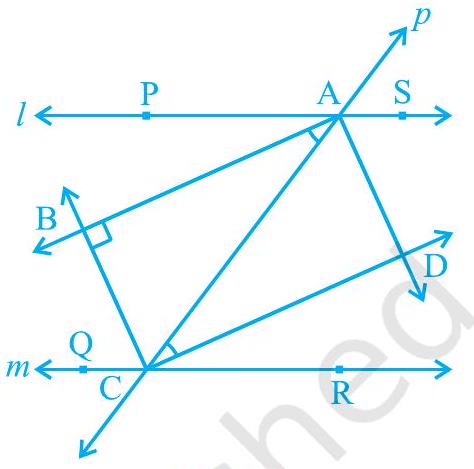
Fig. 8.9
Solution : It is given that PS $|| \mathrm{QR}$ and transversal $p$ intersects them at points A and C respectively.
The bisectors of $\angle \mathrm{PAC}$ and $\angle \mathrm{ACQ}$ intersect at $\mathrm{B}$ and bisectors of $\angle \mathrm{ACR}$ and $\angle \mathrm{SAC}$ intersect at $\mathrm{D}$.
We are to show that quadrilateral $\mathrm{ABCD}$ is a rectangle.
Now, $\quad \angle \mathrm{PAC}=\angle \mathrm{ACR}$
(Alternate angles as $l || m$ and $p$ is a transversal)
So, $\quad \frac{1}{2} \angle \mathrm{PAC}=\frac{1}{2} \angle \mathrm{ACR}$
i.e., $\quad \angle \mathrm{BAC}=\angle \mathrm{ACD}$
These form a pair of alternate angles for lines $\mathrm{AB}$ and $\mathrm{DC}$ with $\mathrm{AC}$ as transversal and they are equal also.
So,$\quad\mathrm{AB} || \mathrm{DC}$
Similarly,$\quad\mathrm{BC} || \mathrm{AD} \quad$ (Considering $\angle \mathrm{ACB}$ and $\angle \mathrm{CAD}$ )
Therefore, quadrilateral $\mathrm{ABCD}$ is a parallelogram.
Also,$\quad\angle \mathrm{PAC}+\angle \mathrm{CAS}=180^{\circ} \quad \text { (Linear pair) }$
So, $\quad \frac{1}{2} \angle \mathrm{PAC}+\frac{1}{2} \angle \mathrm{CAS}=\frac{1}{2} \times 180^{\circ}=90^{\circ}$
or, $\quad \angle \mathrm{BAC}+\angle \mathrm{CAD}=90^{\circ}$
or,$\quad\angle \mathrm{BAD}=90^{\circ}$
So, $\mathrm{ABCD}$ is a parallelogram in which one angle is $90^{\circ}$. Therefore, $\mathrm{ABCD}$ is a rectangle.
Example 5 : Show that the bisectors of angles of a parallelogram form a rectangle.
Solution : Let $\mathrm{P}, \mathrm{Q}, \mathrm{R}$ and $\mathrm{S}$ be the points of intersection of the bisectors of $\angle \mathrm{A}$ and $\angle \mathrm{B}, \angle \mathrm{B}$ and $\angle \mathrm{C}, \angle \mathrm{C}$ and $\angle \mathrm{D}$, and $\angle \mathrm{D}$ and $\angle \mathrm{A}$ respectively of parallelogram $\mathrm{ABCD}$ (see Fig. 8.10).
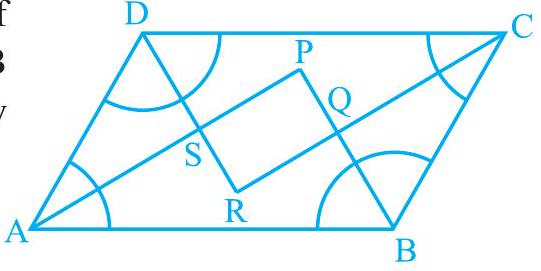
Fig. 8.10
In $\triangle \mathrm{ASD}$, what do you observe?
Since $\mathrm{DS}$ bisects $\angle \mathrm{D}$ and $\mathrm{AS}$ bisects $\angle \mathrm{A}$, therefore,
$$ \begin{aligned} \angle \mathrm{DAS}+\angle \mathrm{ADS} & =\frac{1}{2} \angle \mathrm{A}+\frac{1}{2} \angle \mathrm{D} \\ & =\frac{1}{2}(\angle \mathrm{A}+\angle \mathrm{D}) \\ & =\frac{1}{2} \times 180^{\circ} \\ (\angle \mathrm{A} \text { and } & \angle \mathrm{D} \text { are interior angles on the same side of the transversal} \\ & \left.=90^{\circ} \quad \right) \end{aligned} $$
Also, $\angle \mathrm{DAS}+\angle \mathrm{ADS}+\angle \mathrm{DSA}=180^{\circ} \quad$ (Angle sum property of a triangle)
or,$\quad 90^{\circ}+\angle \mathrm{DSA}=180^{\circ}$
or,$\quad \angle \mathrm{DSA}=90^{\circ}$
So,$\quad \angle \mathrm{PSR}=90^{\circ} \quad($ Being vertically opposite to $\angle \mathrm{DSA})$
Similarly, it can be shown that $\angle \mathrm{APB}=90^{\circ}$ or $\angle \mathrm{SPQ}=90^{\circ}$ (as it was shown for $\angle \mathrm{DSA})$. Similarly, $\angle \mathrm{PQR}=90^{\circ}$ and $\angle \mathrm{SRQ}=90^{\circ}$.
So, PQRS is a quadrilateral in which all angles are right angles.
Can we conclude that it is a rectangle? Let us examine. We have shown that $\angle \mathrm{PSR}=\angle \mathrm{PQR}=90^{\circ}$ and $\angle \mathrm{SPQ}=\angle \mathrm{SRQ}=90^{\circ}$. So both pairs of opposite angles are equal.
Therefore, $\mathrm{PQRS}$ is a parallelogram in which one angle (in fact all angles) is $90^{\circ}$ and so, $\mathrm{PQRS}$ is a rectangle.
8.2 The Mid-point Theorem
You have studied many properties of a triangle as well as a quadrilateral. Now let us study yet another result which is related to the mid-point of sides of a triangle. Perform the following activity.
Draw a triangle and mark the mid-points $\mathrm{E}$ and $\mathrm{F}$ of two sides of the triangle. Join the points $\mathrm{E}$ and $\mathrm{F}$ (see Fig. 8.15).
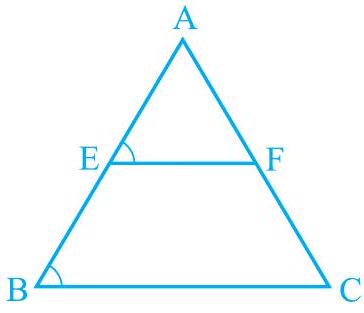
Fig. 8.15
Measure $\mathrm{EF}$ and $\mathrm{BC}$. Measure $\angle \mathrm{AEF}$ and $\angle \mathrm{ABC}$.
What do you observe? You will find that :
$\mathrm{EF}=\frac{1}{2} \mathrm{BC} \text { and } \angle \mathrm{AEF}=\angle \mathrm{ABC}$
so, $\mathrm{EF} || \mathrm{BC}$
Repeat this activity with some more triangles.
So, you arrive at the following theorem:
Theorem 8.8 : The line segment joining the mid-points of two sides of a triangle is parallel to the third side.
You can prove this theorem using the following clue:
Observe Fig 8.16 in which $E$ and $F$ are mid-points of $\mathrm{AB}$ and $\mathrm{AC}$ respectively and $\mathrm{CD} || \mathrm{BA}$.
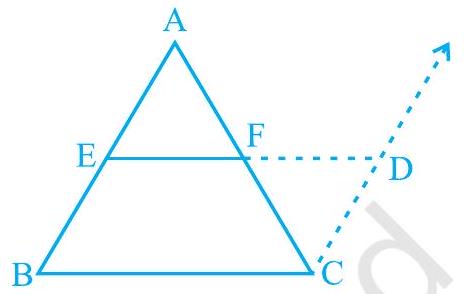
Fig. 8.16
$ \begin{equation*} \Delta \mathrm{AEF} \cong \triangle \mathrm{CDF} \tag{ASAनियम} \end{equation*} $
So, $\quad \mathrm{EF}=\mathrm{DF}$ and $\mathrm{BE}=\mathrm{AE}=\mathrm{DC} \quad($ Why? $)$
Therefore, BCDE is a parallelogram. (Why?)
This gives $\mathrm{EF} || \mathrm{BC}$.
In this case, also note that $\mathrm{EF}=\frac{1}{2} \mathrm{ED}=\frac{1}{2} \mathrm{BC}$.
Can you state the converse of Theorem 8.8? Is the converse true?
You will see that converse of the above theorem is also true which is stated as below:
Theorem 8.9 : The line drawn through the mid-point of one side of a triangle, parallel to another side bisects the third side.
In Fig 8.17, observe that $\mathrm{E}$ is the mid-point of $\mathrm{AB}$, line $l$ is passsing through $\mathrm{E}$ and is parallel to $\mathrm{BC}$ and $\mathrm{CM} || \mathrm{BA}$.
Prove that $\mathrm{AF}=\mathrm{CF}$ by using the congruence of $\triangle \mathrm{AEF}$ and $\triangle \mathrm{CDF}$.
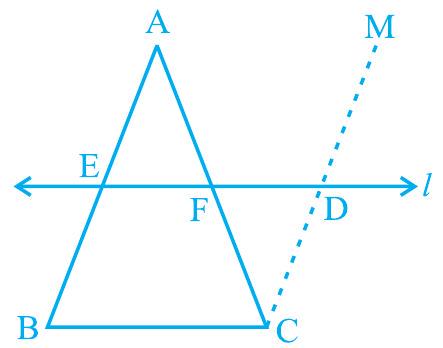
Fig. 8.17
Example 6 : In $\triangle \mathrm{ABC}, \mathrm{D}, \mathrm{E}$ and $\mathrm{F}$ are respectively the mid-points of sides $\mathrm{AB}, \mathrm{BC}$ and $\mathrm{CA}$ (see Fig. 8.18). Show that $\triangle \mathrm{ABC}$ is divided into four congruent triangles by joining $\mathrm{D}, \mathrm{E}$ and $\mathrm{F}$.
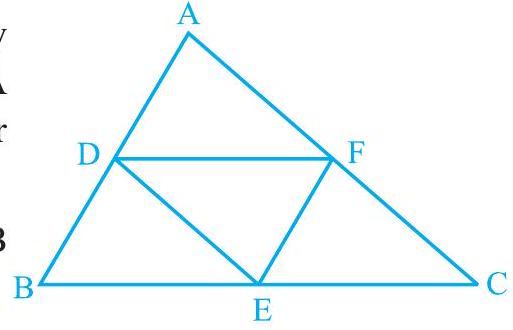
Fig. 8.18
Solution : As D and E are mid-points of sides AB and $\mathrm{BC}$ of the triangle $\mathrm{ABC}$, by Theorem 8.8 ,
Similarly, $\quad \quad \mathrm{DF} || \mathrm{BC}$ and $\mathrm{EF} || \mathrm{AB}$
Therefore ADEF, BDFE and DFCE are all parallelograms.
Now $\mathrm{DE}$ is a diagonal of the parallelogram $\mathrm{BDFE}$,
therefore, $\quad \Delta \mathrm{BDE} \cong \Delta \mathrm{FED}$
Similarly $\quad \Delta \mathrm{DAF} \cong \triangle \mathrm{FED}$
and $\quad \Delta \mathrm{EFC} \cong \triangle \mathrm{FED}$
So, all the four triangles are congruent.
Example 7 : $ l, m$ and $n$ are three parallel lines intersected by transversals $p$ and $q$ such that $l, m$ and $n$ cut off equal intercepts $\mathrm{AB}$ and $\mathrm{BC}$ on $p$ (see Fig. 8.19). Show that $l, m$ and $n$ cut off equal intercepts $\mathrm{DE}$ and $\mathrm{EF}$ on $q$ also.
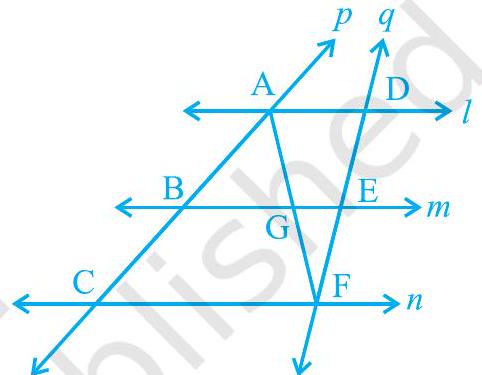
Fig. 8.19
Solution : We are given that $\mathrm{AB}=\mathrm{BC}$ and have to prove that $\mathrm{DE}=\mathrm{EF}$.
Let us join $\mathrm{A}$ to $\mathrm{F}$ intersecting $m$ at $\mathrm{G}$.
The trapezium ACFD is divided into two triangles;
namely $\triangle \mathrm{ACF}$ and $\triangle \mathrm{AFD}$.
In $\triangle \mathrm{ACF}$, it is given that $\mathrm{B}$ is the mid-point of $\mathrm{AC}(\mathrm{AB}=\mathrm{BC})$
and $\quad \mathrm{BG} || \mathrm{CF} \quad($ since $m || n)$.
So, $\mathrm{G}$ is the mid-point of AF (by using Theorem 8.9)
Now, in $\triangle$ AFD, we can apply the same argument as $G$ is the mid-point of AF, $\mathrm{GE} || \mathrm{AD}$ and so by Theorem $8.9, \mathrm{E}$ is the mid-point of $\mathrm{DF}$,
i.e.,$\quad\mathrm{DE}=\mathrm{EF}$.
In other words, $l, m$ and $n$ cut off equal intercepts on $q$ also.
8.3 Summary
In this chapter, you have studied the following points :
1. A diagonal of a parallelogram divides it into two congruent triangles.
2. In a parallelogram,
(i) opposite sides are equal
(ii) opposite angles are equal
(iii) diagonals bisect each other
3. Diagonals of a rectangle bisect each other and are equal and vice-versa.
4. Diagonals of a rhombus bisect each other at right angles and vice-versa.
5. Diagonals of a square bisect each other at right angles and are equal, and vice-versa.
6. The line-segment joining the mid-points of any two sides of a triangle is parallel to the third side and is half of it.
7. A line through the mid-point of a side of a triangle parallel to another side bisects the third side.



